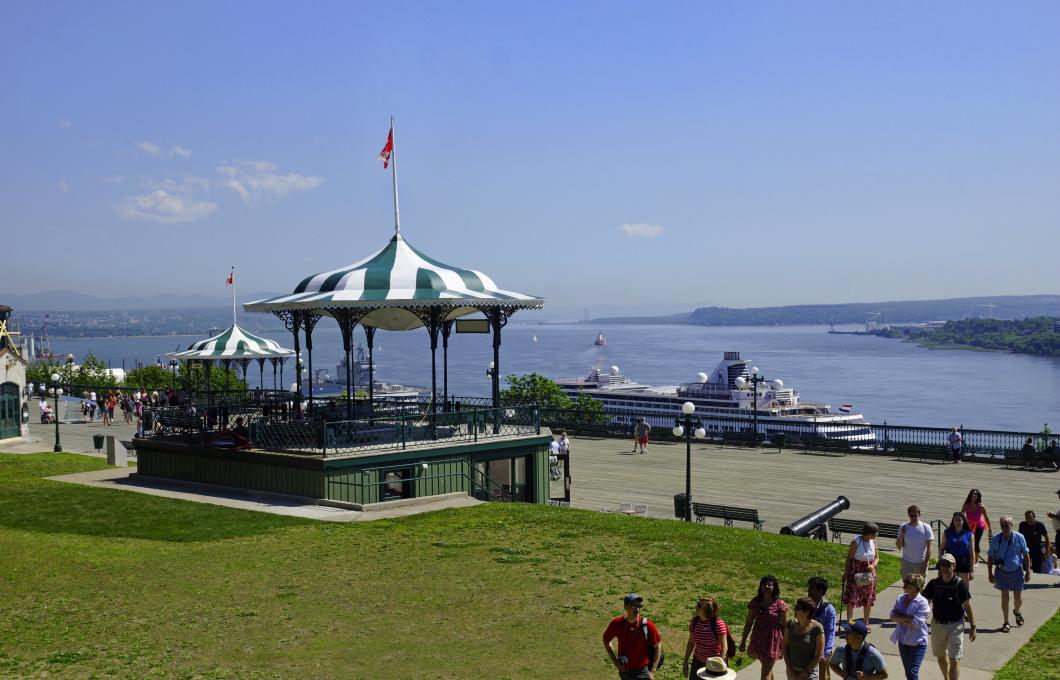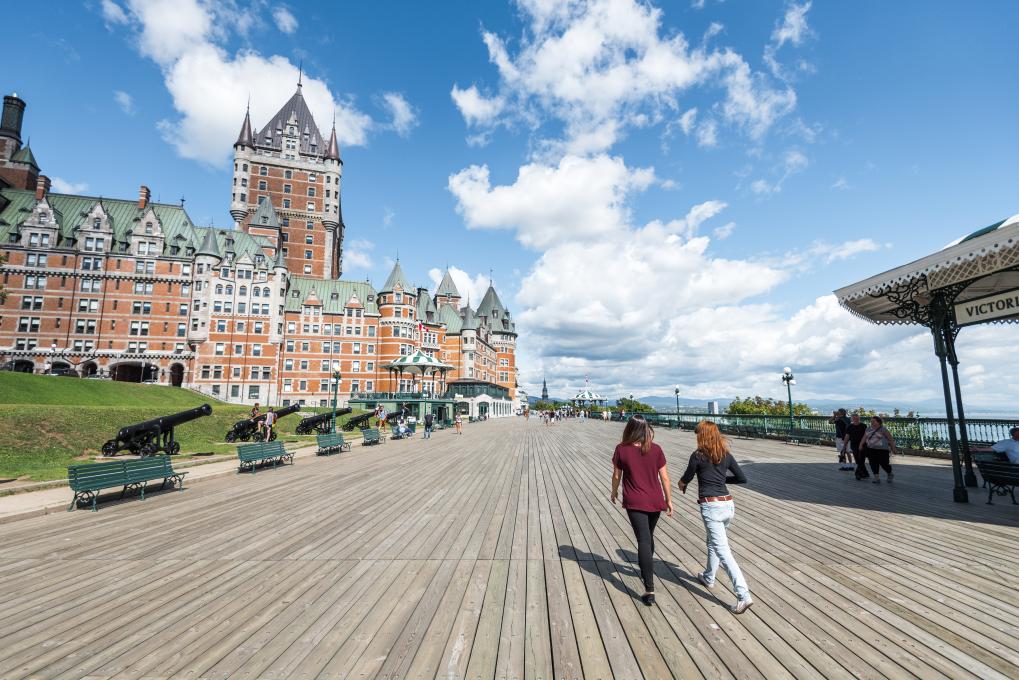Dufferin Terrace
Point of interest
The Dufferin Terrace, a long wooden sidewalk located next to the Château Frontenac, affords a stunning view of the St. Lawrence River and surrounding area. It is a wonderful place to visit at any time of the year!
Thousands of tourists flock to this terrace named in honour of Governor General Dufferin. Long reserved for private use, this magnificent site has proven popular with local residents and tourists alike since its public inauguration in 1838. Countless people come here to take a stroll, relax or admire the landscape.
In the summer, musicians and street entertainers perform on this wooden promenade, while the giant tobogganing run in the winter has been drawing thrill seekers for over one hundred years.
With its breathtaking view of the Château Frontenac, as well as of the St. Lawrence River and surrounding area, the Dufferin Terrace is the perfect spot to take beautiful pictures. It is also here you can board the funicular that will take you down to rue du Petit-Champlain in Lower Town. The Dufferin Terrace is a great place to watch summertime firework displays.
For several years now, it has been possible to visit the ruins of Forts-et-Châteaux-Saint-Louis under the Terrace. This National Historic Site of Parks Canada was once the location of governor's residence for over 200 years.
One never tires of admiring the view from the Dufferin Terrace. This is what makes this attraction so popular with both residents and tourists!
What is there to do at the Dufferin Terrace?
- Watching funny street performers or listening to talented musicians on a pleasant summer's evening;
- Eating an ice cream cone on a sunny day or sipping a cup of hot cocoa while admiring the view in the winter;
- Taking pictures of the Château Frontenac, Québec City's most recognizable landmark that is said to be the most photographed hotel in the world;
- Having your children pose for a photo while sitting on the cannons, which were brought to the city between the late 18th and early 19th century by the British for its defence.
- Here is a little secret: At the far end of the Dufferin Terrace is a staircase with several landings you must climb to get to the governors' promenade, which runs along the Citadel and leads to the Plains of Abraham.
- In the winter, you can go tobogganing down the wooden sledding runs at speeds of up to 70 km/h (43.5 mph). A thrilling activity for the entire family!
- You can visit the ruins of the governor's residence at the Forts-et-Châteaux-Saint-Louis archeological crypt located under the Dufferin Terrace.
Tobogganing on the Dufferin Terrace
Built in 1884, a full 9 years before the opening of the world-famous Château Frontenac, the tobogganing runs on the Dufferin Terrace became a popular winter activity. When you race down the one of the three icy lanes on a special toboggan, you can attain speeds of up to 70 km/h (43.5 mph)—that'll get the adrenaline flowing for sure! The runs are normally open from mid-December to mid-March, and even later if weather permits. Up to four passengers can ride on the same toboggan. So hang on to your tuque and off you go!
The history of the Dufferin Terrace
In 1620, Champlain, the founder of Québec City, built the St. Louis Fort on this site. His successor, Governor Montmagny, had the residence expanded and a terrace installed for his guests. For many years, this building served as the governor's official residence. The terrace remained private and was reserved for dignitaries.
In 1834, a fire destroyed the governor's residence and terrace. In 1838, a first public building was inaugurated by Lord Durham, who decided to have a promenade erected over the ruins of the residence so the population could finally admire the gorgeous view from this vantage point. This promenade was called the Durham Terrace.
In 1854, the terrace proved so popular it was extended. In 1872, the new Governor General, Lord Dufferin, arrived in Québec City. He succeeded in preventing the fortifications from being demolished and supported the project to expand the Durham Terrace. Six stands with green and white roofs were named after important historical figures: Frontenac, Plessis, Dufferin, Victoria, Lorne and Princess Louise.
In 1879, the new terrace was inaugurated. It had been extended from 85 to 430 m (278.9' to 1410.8') and renamed the Dufferin Terrace. It has not been enlarged since. In 1885, electric arc streetlights were installed for the first time in a public place in North America.
In 1898, the statue of Champlain was raised at one end of the Terrace. In 1908, the celebrations marking the 300th anniversary of the founding of Québec City were launched at this spot, as were those for the 400th anniversary in 2008.












